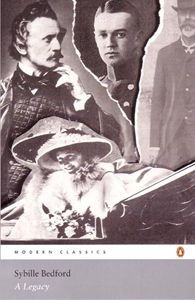 A Legacy by Sybille Bedford (1956).
A Legacy by Sybille Bedford (1956).
Appreciation of Sybille Bedford’s A Legacy by David Leavitt
A Legacy, Sybille Bedford’s remarkable first novel, might most simply be described as the story of two houses. “One was outrageously large and ugly,” Bedford tells us in the opening paragraph; “the other was beautiful. They were a huge Wilhelminian town house in the old West of Berlin, built and inhabited by the parents of my father’s first wife, and a small seventeenth-century château and park in the South, near the Vosges, bought for my father by my mother.”
So Bedford sets us down, with remarkable velocity and confidence, right in the middle of the world to which she is going to devote the next 360 pages. This is the world of Germany before the Second World War. The owners of the Wilhelminian townhouse are Jews; the heroine’s father is a Catholic aristocrat living in a sort of splendid rural poverty. As she is “bundled to and fro” between these two houses, our narrator—a version of Bedford herself—describes for us not just the struggle of her own growing up, but the complex intermingling of three very different families, as well as the rumblings of social and political change that underlie and ultimately disrupt the domestic and marital dramas in which she is enmeshed.
Because Bedford published A Legacy in 1956, her knowledge of what was to come invests the novel with an air of fragility and foreboding. The prose is stunning; raised in a mire of European languages, Bedford clung to English as a life raft, and she shows her gratitude by employing her adopted language with a grace and agility to rival Henry James’s. Yet what is perhaps most astonishing about this astonishingly rich novel—more memorable, for me, even than E. M. Forster’s Howards End, the other great English novel about houses—is the deftness with which its author reconciles two literary virtues that in other hands might seem irreconcilable: intimacy and grandeur.
Total Points: 5 (DL 5)